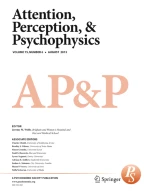Abstract
Stevens’s direct scaling methods rest on the assumption that subjects are capable of reporting or producing ratios of sensation magnitudes. Only recently, however, did an axiomatization proposed by Narens (1996) specify necessary conditions for this assumption that may be put to an empirical test. In the present investigation, Narens’s central axioms ofcommutativity andmultiplicativity were evaluated by having subjects produce loudness ratios. It turned out that the adjustments were consistent with the commutativity condition; multiplicativity (the fact that consecutive doubling and tripling of loudness should be equivalent to making the starting intensity six times as loud), however, was violated in a significant number of cases. According to Narens’s (1996) axiomatization, this outcome implies that although in principle a ratio scale of loudness exists, the numbers used by subjects to describe sensation ratios may not be taken at face value.
Article PDF
Similar content being viewed by others
Avoid common mistakes on your manuscript.
References
Algom, D., &Marks, L. E. (1984). Individual differences in loudness processing and loudness scales.Journal of Experimental Psychology: General,113, 571–593.
Attneave, F. (1962). Perception and related areas. In S. Koch (Ed.),Psychology: A study of a science (Vol. 4, pp. 619–659). New York: McGraw-Hill.
Birnbaum, M. H. (1982). Controversies in psychological measurement. In B. Wegener (Ed.),Social attitudes and psychological measurement (pp. 401–485). Hillsdale, NJ: Erlbaum.
Birnbaum, M. H. (1990). Scale convergence and psychophysical laws. In H.-G. Geissler (Ed.),Psychophysical exploration of mental structures (pp. 49–57). Toronto: Hogrefe & Huber.
Birnbaum.M. H., Anderson.C., &Hynan, L. (1989). Two operations for “ratios” and “differences” of distances on the mental map.Journal of Experimental Psychology: Human Perception & Performance,15, 785–796.
Buus, S., Florentine, M., &Poulsen, T. (1997). Temporal integration of loudness, loudness discrimination, and the form of the loudness function.Journal of the Acoustical Society of America,101, 669–680.
Collins.A. A., &Gescheider, G. A. (1989). The measurement of loudness in children and adults by absolute magnitude estimation and cross-modality matching.Journal of the Acoustical Society of America,85, 2012–2021.
Gescheider, G. A. (1997).Psychophysics. The fundamentals (3rd ed.). Mahwah. NJ: Erlbaum.
Hellström, Å. (1978). Factors producing and factors not producing time errors: An experiment with loudness comparisons.Perception & Psychophysics,23, 433–444.
Iverson.G., &Luce, R. D. (1998). The representational measurement approach to psychophysical and judgmental problems. In M. H. Birnbaum (Ed.),Measurement, judgment, and decision making (pp. 1–79). San Diego: Academic Press.
Krantz.D. H. (1972). A theory of magnitude estimation and cross-modality matching.Journal of Mathematical Psychology,9, 168–199.
Krantz, D. H., Luce.R. D., Suppes, P., &Tversky.A. (1971).Foundations of measurement (Vol. 1 ). New York: Academic Press.
Logue.A. W. (1976). Individual differences in magnitude estimation of loudness.Perception & Psychophysics,19, 279–280.
Luce, R. D. (1959). On the possible psychophysical laws.Psychological Review,66, 81–95.
Luce.R. D. (1990). “On the possible psychophysical laws” revisited: Remarks on cross-modal matching.Psychological Review,97, 66–77.
Luce, R. D., &Krumhansi, C. L. (1988). Measurement, scaling, and psychophysics. In R. C. Atkinson, R. J. Herrnstein, L. Gardner, & R. D. Luce (Eds.),Stevens’ handbook of experimental psychology: Vol. I. Perception and motivation (2nd ed., pp. 9–74). New York: Wiley.
Marks, L. E., &Algom, D. (1998). Psychophysical scaling. In M. H. Birnbaum (Ed.),Measurement, judgment, and decision making (pp. 81–178). San Diego: Academic Press.
Mellers.B. A., Davis, D. M., &Birnbaum, M. A. (1984). Weight of evidence supports one operation for “ratios” and “differences” of heaviness.Journal of Experimental Psychology: Human Perception & Performance,10, 216–230.
Merkel.J. (1888). Die Abhängigkeit zwischen Reiz und Empfindung.Philosophische Studien,4, 541–594.
Narens.L. (1996). A theory of ratio magnitude estimation.Journal of Mathematical Psychology,40, 109–129.
Narens, L. (1997). On subjective intensity and its measurement. In A. A. J. Marley (Ed.),Choice, decision, and measurement: Essays in honor of R. Duncan Luce (pp. 189–205). Mahwah, NJ: Erlbaum.
Narens, L., &Luce, R. D. (1986). Measurement: The theory of numerical assignments.Psychological Bulletin,99, 166–180.
Parker, S., &Schneider, B. (1994). The stimulus range effect: Evidence for top-down control of sensory intensity in audition.Perception & Psychophysics.56, 1–11.
Peißner, M. (1999). Experimente zur direkten Skalierbarkeit von gesehenen Helligkeiten [Experiments on the direct scalability of perceived brightness]. Unpublished master’s thesis, Universität Regensburg.
Popper, R., Parker, S., &Galanter, E. (1986). Dual loudness scales in individual subjects.Journal of Experimental Psychology: Human Perception & Performance,12, 61–69.
Richardson, L. F., &Ross, J. S. (1930). Loudness and telephone current.Journal of General Psychology,3, 288–306.
Rule, S. J., &Curtis, D. W. (1978). Levels of sensory and judgmental processing: Strategies for the evaluation of a model. In B. Wegener (Ed.),Social attitudes and psychophysical measurement (pp. 107–122). Hillsdale, NJ: Erlbaum.
Schneider, B. A. (1980). A technique for the nonmetric analysis of paired comparisons of psychological intervals.Psychometrika,45, 357–372.
Schneider, B. A., &Cohen, A. J. (1997). Binaural additivity of loudness in children and adults.Perception & Psychophysics,59, 655–664.
Schneider, B. [A.], Parker.S., Farrell, G., &Kanow, G. (1976). The perceptual basis of loudness ratio judgments.Perception & Psychophysics,19, 309–320.
Schneider, B. [A.], Parker, S., &Stein, D. (1974). The measurement of loudness using direct comparisons of sensory intervals.Journal of Mathematical Psychology,11, 259–273.
Shepard, R. N. (1981). Psychological relations and psychophysical scales: On the status of “direct” psychophysical measurement.Journal of Mathematical Psychology,24, 21–57.
Stevens, J. C., Mack, J. D., &Stevens, S. S. (1960). Growth of sensation on seven continua as measured by force of handgrip.Journal of Experimental Psychology,59, 60–67.
Stevens, S. S. (1946). On the theory of scales of measurement.Science,103, 677–680.
Stevens.S. S. (1951 ). Mathematics, measurement and psychophysics. In S. S. Stevens (Ed.),Handbook of experimental psychology (pp. 1–49). New York: Wiley.
Stevens, S. S. (1956). The direct estimation of sensory magnitude- loudness.American Journal of Psychology,69, 1–15.
Stevens.S. S. (1957). On the psychophysical law.Psychological Review.64, 153–181.
Stevens, S. S. (1975).Psychophysics: Introduction to its perceptual, neural, and social prospects. New York: Wiley.
Stevens, S. S., &Greenbaum, H. B. (1966). Regression effect in psychophysical judgment.Perception & Psychophysics,1, 439–446.
Teghtsoonian, M., &Teghtsoonian, R. (1971). How repeatable are Stevens’s power law exponents for individual subjects?Perception & Psychophysics,10, 147–149.
Author information
Authors and Affiliations
Corresponding author
Rights and permissions
About this article
Cite this article
Ellermeier, W., Faulhammer, G. Empirical evaluation of axioms fundamental to Stevens’s ratio-scaling approach: I. Loudness production. Perception & Psychophysics 62, 1505–1511 (2000). https://doi.org/10.3758/BF03212151
Received:
Accepted:
Issue Date:
DOI: https://doi.org/10.3758/BF03212151
